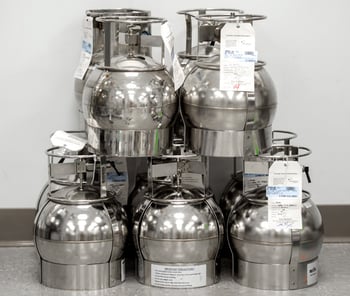Interpreting Volatile Organic Compounds Data in Air

Pace® recently delivered a live webinar titled “INTERPRETING VOLATILE ORGANIC COMPOUNDS (VOC) DATA IN AIR.” This webinar was widely attended and those of you who participated are familiar with the challenges discussed. In this blog, we seek to outline a few of the questions tackled during the webinar.
Q: How can I use the QA data in the laboratory report to help determine if unexpected hits are due to canister contamination?
For EPA Method TO-15 batch certification is the routine level to check cleanliness. This entails selecting one canister from the cleaning batch, usually the one that had the highest concentrations, and running a full TO-15 analysis on this canister. If the results of this test come out below routine reporting limits, then the whole batch of canisters are certified clean to that level.
Start by verifying the batch certification of the canisters mentioned in the report. Check if all indoor air samples are from the same batch. Next, confirm if the ambient air sample canisters match the batch of the indoor air sample canister. Typically, the ambient air samples are usually the cleanest. If the hits and detections are consistent with the indoor air sample, it's probable that there are fugitive emissions.
The lab should also have an audit trail tying both canisters and flow controllers to previous sample results. Upon request, the lab can review this data to determine if there could be residual contamination from the last usage.
Q: Is there anything I can do as an additional check to the batch certification process?
Yes, it is not a method requirement, but you can request a trip blank canister that would travel to the site and back to the lab unopened like those for a water sample. Trip blank results are used as indicators of contamination originating from the proximity of sample containers to one another during shipment and storage.
Q: How do pressure readings impact usability?

The ideal final vacuum for time weighted canister samples is around -5”Hg. Depending on the type of sample collected, this will be more or less critical. It’s most important for ambient or indoor air samples to ensure that sample was collected over the desired duration. If you return to a site the following day to find the vacuum reading at zero, it may be impossible to determine how long it collected for. When it comes to soil gas or sub-slab samples it’s typically less critical. Most are flow restricted to prevent surface area preferential pathways rather than to collect a time weighted sample. True grab samples aren’t restricted at all and will fill to zero without an attached flow controller. On the opposite end of the spectrum, if the canister does not collect enough sample (remaining vacuum > -15”Hg), dilutions may be required for the lab to extract enough sample for analysis.
Occasionally samples may be received in the lab with positive pressure. This can occur when samples are collected in a cold environment and then the pressure is checked in the room temperature laboratory. A difference of 33 degrees Fahrenheit in temperature results in a 1.0”Hg pressure increase.
Q: Why are my sample results higher this time around?
There are a myriad of reasons why sample results may be higher this time around. There might have been a change in pressure differential between the indoor air space and the sub-slab since the previous sampling event. Weather factors, such as a decrease in barometric pressure, can also influence results. Higher water table levels might push polluted soil gas upwards. Moreover, if there is a rise in contaminant levels in groundwater, the concentration in soil gas will also go up.
Have questions? We have answers!

.png)
.png)